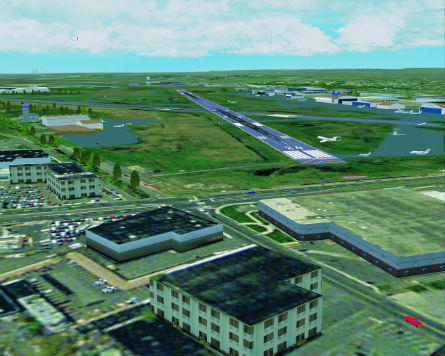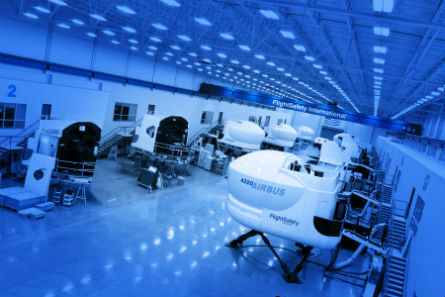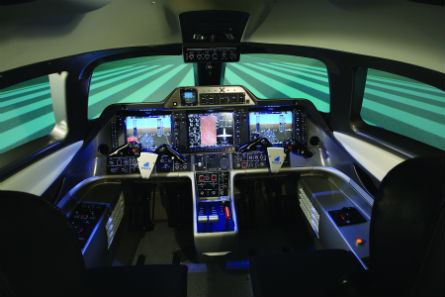Wanted in next 20 years: about 500,000 airline pilots and 600,000 maintenance technicians to safely fly and maintain a world fleet of 40,000 highly complex aircraft carrying billions of passengers.
Keeping pace with the industry's forecast will require training providers to grapple with technological and regulatory challenges in order to deliver highly skilled, competent aviation professionals.
FlightSafety International has been in business for 61 years and gone through several downturns and recovery cycles, says FlightSafety executive vice-president Eric Hinson: "There will always be a demand for high-quality professionals, whether pilots, cabin crew or maintainers, and in all facets of aviation, be it business aviation, commercial or military."
FlightSafety provides flight simulators, visual systems and displays to commercial, government and military organisations and provides more than a million hours of training annually to pilots, technicians and aviation professionals from some 150 countries. It offers training at 40 learning centres in the USA and 10 other countries, has a fleet of advanced full-flight simulators (FFSs) and, as of early June, had built more than 800 simulators.
 |
|---|
| Flightsafety International Flightsafety International visual systems offer continuous global high-resolution satellite imagery |
WIDER FIELDS
To support demand, FlightSafety last year added a 19-bay, 375,000ft2 (34.83m2) design, manufacturing and support facility in the USA at Tulsa, Oklahoma, staffed by 700, mostly engineers and technicians.
"Our focus now is how do we build a device that produces a better pilot and on higher fidelity visuals that have wider FOVs [fields of view]. We want to make that synthetic environment as realistic as possible," says FlightSafety vice-president of simulation Rick Armstrong. "FlightSafety has its own visual/optics company and has invested in what it calls a rigid mirror or glass mirror system, which allows increased, almost unlimited FOV. We are also increasing the fidelity of visual models. Computing power today allows you to go beyond high definition. 3-D visuals are possible."
FlightSafety vice-president of operations Greg McGowan notes increasing demand for more customised training. This is driven by a number of factors, including operators' SMS [safety management system] initiatives. "They are asking for company-specific items to be included in their training programme," says McGowan. "The challenge from a training point of view is having to overlay or compare approved training programmes under Parts 142 and 92, then make adjustments to satisfy both [regulatory and safety management system programme] requirements."
FlightSafety, which pioneered electric motion systems, is working to improve motion fidelity, icing models and aerodynamic models "that are more closely aligned to what aircraft and pilots see [in upsets]", adds Armstrong.
 |
|---|
| FlightSafety International FlightSafety International opened a new facility near Tulsa last year |
The Air Line Pilots Association (ALPA) aviation safety chair Charles Hogeman says: "We want to see that the devices used for training and the training itself is as close to the real world as possible. We want the highest fidelity training devices used to train pilots to fly aircraft under different scenarios." ALPA represents more than 53,000 pilots at 37 US and Canadian airlines. He notes that the term "automated cockpit" does not mean the aircraft are easier to fly. Rather, operating them requires a different skill set to manage the automation.
And one of the biggest challenges ahead for simulator manufacturers is replicating the complex avionics systems on new aircraft in a synthetic environment, says Armstrong: "The avionics systems on modern aircraft are just a quantum leap in terms of their complexity. And in the sims, we have to do things that the actual avionics don't do, such as repositioning for flight."
FlightSafety is seeing strong market activity in corporate, helicopter and military sectors, says Armstrong, which is likely being driven by "the value proposition of training in simulators versus aircraft".
Over the past couple of years, Hinson notes, FlightSafety has seen a significant increase in demand for well-qualified maintainers. Requirements for maintainers have changed with the increasing sophistication of aircraft coming to market, says Hinson: "No longer does a candidate obtain the A&P [airframe and powerplant licence] and then get OJT [on-the-job training]. They are now required to know specifically how to maintain the exact aircraft they will be working on."
FlightSafety has developed extensive maintenance training programmes and dedicated training centres, and plans more. It has partnered with Pratt & Whitney Canada to offer engine training around the world. Engine training is matched with appropriate aircraft types, and customers can get airframe and engine training at one location, which has been a boon to maintenance training.
RISING SOPHISTICATION
Canadian simulator maker and training provider CAE is "committed to being very customer-centric [and] flexible to help customers achieve goals identified in their business model", says group president Jeff Roberts.
"Customers are seeking products and services that help them enhance safety and help them deal with the changing demographics of the pilot community, with the increased sophistication and capability of the aircraft they are flying and the dynamic physical environment they are operating in," he adds. "The training paradigm is really trying to be more operational, to provide more realism and scenario-based training, and create more 'holistic' or richer training experiences - and making those capabilities available in more and more ways, be it distance learning, or line-oriented flight training."
CAE continues to invest an average of 10% of revenue in research and development because it believes "technology can and is a differentiator and can and will be an efficiency and effectiveness-of-training driver", notes Roberts. He adds that CAE believes in being a "glocal" (for global-local) company: that is, being a global player while working with customers to develop their local markets with people and infrastructure on the ground.
In the commercial arena, CAE has 35 facilities around the world with 145-150 FFSs focused exclusively in commercial aviation. The company trains about 1,400 pilot candidates per annum. In May, it acquired Oxford Aviation Academy, its seven training facilities and 40 simulators. The combined businesses have been rebranded as CAE Oxford Aviation, replacing CAE Global Academy. The deal includes Parc Aviation, which has 1,200 aviation personnel around the world with 50 airlines. This means CAE is also in the aviation personnel sourcing business, providing crews on demand for airlines.
UNMANNED FUTURE
One new idea is the operation of unmanned aircraft systems in the National Airspace System (NAS). The FAA director of flight standards, John Allen, predicts that "UASs will have as much of an impact on aviation as the jet engine".
The military introduced the jet in WWII, but it was not until the 1950s that infrastructure to accommodate the jet existed.
"Now, out of the military come UASs and we are adjusting NAS procedures and getting manufacturers to adjust equipment for operation in the NAS," says Allen.
But UASs will be part of the landscape - which means the industry must prepare for UAS pilot training. In the military world of UASs, pilots control the aircraft from ground stations. The concern is whether UAS crews would require a pilot's licence and attendant knowledge to operate in the skies populated by manned aircraft.
Perhaps the most controversial training regulatory challenge that has emerged is the Airline Safety and FAA Extension Act of 2010 (Public Law 111.216). The legislation, referred to as the "1500 rule," and its associated FAA proposed rulemaking - Docket No FAA 2010-0100 at www.regulations.com - requires first officers to obtain an air transport pilot certificate - and log its required 1,500 flight hours - to qualify for the right seat. A first officer with 250 hours would qualify for a right-seat job.
According to industry estimates, a private pilot licence alone can cost about $10,000; obtaining all the certificates to qualify for an airline job, about $60,000, and a four-year degree, $160,000. The FAA has proposed decreasing the required flight hours to 750.
Supporters of the ATP provision say the hours-based training is a reliable tried and true training method, involving the acquisition of certificates and ratings and flight hours to progress through the ranks and migrate up to the majors.
Hours-based training is prevalent in the USA, but the rest of the world, says CAE's Roberts, seems to opt for more specific, focused training models, such as the multi-crew pilot licence. The MPL is a intensive, competency-based, ab initio programme that trains zero-time pilots for a job as a first officer.
Opponents of the 1500 rule argue that quality training that addresses specific job requirements of airline operations is needed.
ALPA, which supports the 1500 rule, also supports the advanced qualification programme (AQP) as an alternative to traditional training methods. AQP allows airlines to employ technology and a methodical curriculum development process and better prepares the pilots to fly for that airline, says Hogeman.
CAE graduated the first MPL class of cadets from AirAsia in July 2011. FlightSafety has not seen much demand for MPL, but Hinson predicts that "eventually, the market will move towards this kind of solution", adding: "We are prepared to provide it based on customers' needs."
Whatever happens in the evolution of training, an industry official says, "we have to be willing to take a little risk and explore the capabilities of these devices in conjunction with background and thinking and experience of pilots. We cannot be static or we set ourselves up for failure."
CAE TRAINS SIGHTS ON QUALITY
CAE HAS developed the Simulation Operations Quality Assurance (SOQA) tool, which debuted in April at World Aviation Conference and Trade Show. It is flight operations quality assurance (FOQA) for the simulation training environment, aiming to help customers evaluate the effectiveness of its simulator programmes as well as improving training.
CAE chief safety officer Lou Nemeth describes it as "a training system performance tool. It is many tools. It is a simulator, a data capture station and it has the ability to generate reports from a database. It is a visualisation tool and can help identify unsafe indicators in a system. It's a tool to justify new training and new behaviours."
SOQA can help identify when standard operating procedures - such as lowering flaps at prescribed airspeed - are not being followed. It allows trainers insight as to why they are not being followed and how to get crews back on track. SOQA enables trainers to aggregate data across the same aircraft type at an individual operator or across operators. A sim cockpit video, outside aircraft view, flight control movements and readouts are available for review by the instructor and flight crew.
Addressing privacy concerns, Nemeth says that, as with FOQA, it is up to the operator to decide how and for how long data are stored: "As an ab initio trainer of pilots. I am not bound by the same kind of union and liability issues that an airline has. So I would want to keep data for a long time. That data are valuable to me to determine adequacy of training."
 |
|---|
| CAE This screen view shows data from a Boeing 737 upset recovery training session |
INTRODUCTORY SIMULATION TRAINING A FAMILY AFFAIR FOR FRASCA
FAMILY-OWNED AND operated Frasca International has been in simulator making since 1958, and continues to adapt to an evolving training market guided by founder and chairman Rudy Frasca.
Frasca has extended its reach from the first simulator Rudy Frasca built in his garage to a global market. Its diverse product line now spans full-flight simulators (FFSs) and flight training devices (FTDs) for fixed-wing - piston- and turbine-powered - and rotary aircraft. Products for fixed-wing pistons include the Cessna 172 Skyhawk Level 5 and Diamond DA40/DA42 FTDs, and for fixed-wing turbines: the Cessna 208 Caravan Level B FFS, the very light jet (Embraer Phenom/Cessna Mustang) FTD, and the CRJ Canadair Regional Jet FTD. In the rotary realm, Frasca offers a Eurocopter EC135 FTD as well as the Eurocopter EC225 and Sikorsky S92 Level B FFS.
VARIED CLIENTS
Close to 100 universities in the USA use Frasca devices - including the University of North Dakota and Embry-Riddle Aeronautical University at its Prescott, Arizona and Daytona, Florida campuses. General aviation primary flight training schools also deploy Frasca products: Batavia, Ohio-based Sporty's, which has been in the business of flight education for over 50 years, has installed Frasca's Mentor Cessna 172S advanced aviation training device (AATD) at its flight academy at Clermont County airport. In May, Sporty's partnered with Frasca to develop simulator training programmes for flight students. Frasca's mixed customer base also spans Houston-based Bristow Group, the Angolan and Philippine air forces , and the German federal police. Frasca has delivered over 2,500 FFSs/FTDs.
Based at a 70,000sq ft facility at Urbana, Illinois, Frasca employs 180 people and produces an average of 80 devices each year. Its business is split about 50:50 between helicopters and fixed-wing aircraft, says president and chief executive John Frasca, who heads what he labels a "vertically integrated company" with a goal of "building high quality simulation to meet customer requirements. And the general push is for higher and higher fidelity-and that can be in the aerodynamics, in the visuals."
At the low - but still demanding -- end of the spectrum, customers want the training envelope expanded from what it was 10 years ago - "primarily instrument flight, a little visual, the ability to see the runway when you come out of the clouds. Now, visual is the principal requirement: they want to see everything out the window and do all VFR manoeuvres," says Frasca.
 |
|---|
| Frasca Frasca's very light jet FTD can replicate Phenom cockpits |
Budgets may be more sensitive for the smaller operators, but they still demand fidelity, laying emphasis on use of Level 6 and 7 FTDs.
Frasca says "a tremendous amount" of introductory training, such as VFR turns, can be done in the simulator. Because a limited amount of testing is allowed in an FTD, students would learn and practise manoeuvres in the FTD and then schedule flight time to practise and be tested for proficiency.
"In that market, where you are flying low and slow, imagery must be pretty darn good," says Frasca. "We use satellite imagery, and on the Mentor advanced aviation training device, we use actual Garmin 1000 avionics. Customers want to see all the sources of data line up."
Frasca has made its own visual systems and built the systems' databases for 25 years. The fidelity requirement led Frasca to make its own control loading systems. It with spring control loaders in the early FTDs that Rudy Frasca built, then evolved to electric systems with brushless DC motors.
MISSION PROFILE
The high end of the market opts for FFSs, and Frasca is creating mission scenarios to fulfil the demand by oil company, aeromedical and law enforcement customers for mission training - to fly to an oil rig, an accident site or crime scene in all-weather, day-night conditions.
The company also flight-tests aircraft such as the Sikorsky S-92 and Eurocopter EC225 to collect data packages because, as Frasca explains, civil aviation authorities' requirements are much more data-driven. "We now have to prove the digital data collected on the aircraft matches the digital data collected from the simulator."
And new product development continues. One new Frasca training tool is the SAFTEVAT (VAT for virtual air traffic) aimed at making ATC communications in the simulation environment more realistic.
Source: Flight International























